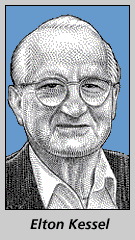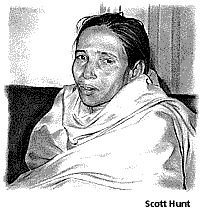
|
Fanatical veterans of the NSSM 200 frenzy:
AMERICANS EXPORT CHEMICAL STERILIZATION TO THE THIRD WORLD How many more "wild geese" in business suits are involved in the global demographic war?
by Alix M. Freedman, Staff Reporter |

|
Fanatical veterans of the NSSM 200 frenzy:
AMERICANS EXPORT CHEMICAL STERILIZATION TO THE THIRD WORLD How many more "wild geese" in business suits are involved in the global demographic war?
by Alix M. Freedman, Staff Reporter |
Stephen D. Mumford's house looks much like any other in the leafy
suburbs of Chapel Hill, N.C. Set on a one-acre plot, his brick-and-wood
home features four bedrooms, an eat-in kitchen and a cozy den. Outside,
there's a vegetable garden and a garage with a station wagon parked in
front.

No one would ever guess what he has in his basement.
Down there are more than 300,000 tiny yellow pellets in rows of white plastic jars. The pellets, made of a compound known as quinacrine, are bound for India, Pakistan, Bangladesh, Morocco and more than a dozen other countries. There, in remote, often filthy clinics and doctors' offices, they will be used to sterilize some of the world's poorest women.
In the past decade, quinacrine pellets supplied by Mr. Mumford have been responsible for the irreversible chemical sterilization of more than 100,000 Third World women. There are enough pellets in his basement at the moment to sterilize 20,000 more. (See sterilization tally board.)
Inserted directly into the uterus, quinacrine (pronounced KWIN-a-krin) prevents pregnancy by scarring the fallopian tubes. No anesthesia is used, and the procedure is painful; some women faint. For many, short-term side effects include abnormal menstrual bleeding, backaches, fever, lower abdominal pain and headaches.
Longer-term consequences are less certain but potentially more ominous: Independent laboratory studies in the U.S. indicate that quinacrine causes cells to mutate. Some scientists say this is circumstantial evidence that it may cause cancer as well; according to the World Health Organization, between 60% and 80% of known mutagens are also carcinogens.
Because questions of safety and effectiveness haven't been resolved, quinacrine sterilizations aren't permitted in the U.S. They are also opposed by nearly all major family-planning organizations and by many foreign governments. In 1993, the World Health Organization declared that, pending further lab research, quinacrine shouldn't be used to sterilize women in any country because of the potential cancer risk.

World-wide, Mr. Mumford and his partner, a like-minded contraceptive researcher named Elton Kessel, are the sole distributors of the substance. In a remarkably quiet crusade, they have managed to pay for its manufacture in Switzerland, arrange for its free distribution in about 20 countries and mobilize a far-flung network of doctors, nurses and midwives to administer it.
Operating mostly in impoverished nations with weak regulation of health-care practices, the two Americans have bypassed the stringent controls that typically govern the testing and use of experimental drugs. As a result, mass-sterilization programs affecting thousands of women, but involving limited health-related follow-up, have been launched in several countries. In addition, some women seeking routine gynecological care have been sterilized without their knowledge or even against their will.
The two American promoters say that, judging by the information they have gathered from human testing abroad, quinacrine is both safe and effective. They acknowledge that quinacrine pellets cause mutations in certain test-tube studies but note that research on mice has been inconclusive. In any case, they say, the lab results hardly prove that the pellets cause cancer in women.
Their primary goal, they emphasize, is to improve the lives and protect the health of Third World women, almost 600,000 of whom die each year from pregnancy-related complications. The World Health Organization, which advises the United Nations and its members, reports that the incidence of such deaths is 18 times as high in the developing world as it is in industrialized countries.
But Mr. Mumford, 55, is also pursuing a more controversial agenda than health care. Describing quinacrine as "essential to population-growth control," he says he sees it as a means of reducing the potential number of immigrants to the U.S. from developing nations. "This explosion in human numbers, which after 2050 will come entirely from immigrants and the offspring of immigrants, will dominate our lives. There will be chaos and anarchy," says Mr. Mumford, who relies in part on anti-immigrant forces in the U.S. for financial backing.
Mr. Mumford blames the Catholic Church for discouraging population control while promoting the migration of Catholics to the U.S. to bolster the strength of the church in this country. "Overpopulation is a gravely serious national-security issue, even more serious than the nuclear threat," warns Mr. Mumford, who calls his tiny, not-for-profit organization the Center for Research on Population and Security. "The security survival interest of the U.S. is in conflict with the papacy's long-term survival," he adds.
A researcher with these political views and no support from drug companies, health groups or national governments might be expected to encounter trouble bringing a product to market. But quinacrine is so inexpensive -- about a penny per pellet -- that Mr. Mumford's organization has had to spend only $36,000 for the three million pellets it has had manufactured in this decade. Mr. Mumford and Dr. Kessel, who is 79, also benefit from the fact that they don't seek financial gain, are willing to operate on a shoestring -- and are passionately persistent. "If you want to make a difference in contraceptive research, you have to take a vow of poverty," Dr. Kessel says.
Mr. Mumford draws a salary of $37,500 a year from his research center; Dr. Kessel lives off less than $30,000 from Social Security and income from small investments.
Many people in the family planning field think the two men's quinacrine crusade is nothing short of evil. Adrienne Germain, president of the International Women's Health Coalition in New York, says that quinacrine's inexpensiveness, portability and simplicity make it "highly open to abuse," adding that, "with this, there is no murky middle. It shouldn't be used, period."
At the World Bank, which provides loans for family planning, population official Thomas Merrick says that quinacrine use abroad "gives the impression that we have different standards for poor women." He adds, "This undermines the cause of developing safe, effective and acceptable methods that respect the reproductive rights of women in the Third World."
Numerous women's-rights advocates world-wide agree. But, as in many areas where the Western health establishment comes into contact with the developing world, the quinacrine issue isn't as simple as many may believe. Some health-care workers in the Third World, desperate for cheap, easy-to-administer birth control, see the two maverick Americans as saviors -- and their critics as dangerous meddlers.
|
'First, let these women be accepted as humans
and then let's talk about human rights. As it is, they're going to die, so
what do the long-term complications of quinacrine matter?'
-- Dr. Naseem Rahman |

|
One
outspoken quinacrine advocate is gynecologist Naseem Rahman. On a Sunday in late January, she threads her way through a Dhaka, Bangladesh, slum inhabited by stonecutters and rickshaw pullers and speaks to women about birth control. She says she will send her health workers back here soon to spread the word about the free quinacrine sterilizations that she provides at her private clinic.She believes that the developed world's cautious standards of medical ethics and safety have no place in the lives of women for whom repeated pregnancies bring nothing but deprivation and danger. Quinacrine, she points out, is dramatically less expensive than any alternative she can provide (see accompanying chart).
A few feet away from Dr. Rahman, a whimpering woman clutches a dead baby to her breast. The doctor declares: "First, let these women be accepted as humans and then let's talk about human rights. As it is, they're going to die, so what do the long-term complications of quinacrine matter?"
Quinacrine's vast appeal, and its considerable dangers, are also on display in Vietnam.

| 'Any method that is easy can be abused, but you have to weigh the benefits,' says Dr. Do Trong Hieu, Vietnam's family planning director. He still keeps a stash of quinacrine in a desk drawer. |
In 1986, Dr. Kessel buttonholed Do Trong Hieu, Vietnam's family planning director, at a seminar in New Delhi, and told him about quinacrine. On the spot, Dr. Kessel supplied Dr. Hieu with a number of quinacrine pellets.
At the time, Vietnam's population growth was among the fastest in Asia, the country's economy was in a state of collapse -- and the ministry of health had a budget that provided barely 15 cents per woman for family planning. Vietnam's only widely available family planning option was the IUD. But many women complained about the side effects and, for the government, price was a concern: about $2.50 per woman compared with $1 per woman for quinacrine, including all clinic-related costs.
"Quinacrine didn't require surgery, was easy to provide to users and was cheap," Dr. Hieu recalls. "I said, 'This would be good for a poor country.' "
He began a quinacrine-sterilization effort that ballooned so quickly that more than 31,000 Vietnamese women had been sterilized before the government decided to follow up on the women's progress three years later.
After this period, no increased incidence of cancer or other serious complications was detected. But the government's study revealed that some health workers performing the sterilizations were recording pregnancy rates of 13% -- not the desired 2%. The apparent reason: Some of the 1,300 health workers who had been hastily enlisted to do the sterilizations hadn't been properly trained. By the time Dr. Hieu sorted all this out, 20,000 more Vietnamese women had been sterilized, Mr. Mumford says. The program was dropped in 1993 under intense pressure from the World Health Organization.
It also turned out that not everyone who had been sterilized had undergone the procedure voluntarily. Many of the involuntary sterilizations had occurred in a remote area five hours by car from Ho Chi Minh City, on the Hoa Binh Rubber Plantation.
Hoa Binh rubber worker Nguyen Thi recalls that on March 10, 1993, she went to the plantation health clinic, where she was told that she would receive a routine gynecological examination. Instead, Duong Dang Hanh, the clinic's doctor, removed Mrs. Thi's IUD and sterilized her with quinacrine.
Dr. Hanh performed the same procedure on 106 other unsuspecting rubber workers, he confirms. Only later, after some got infections and sought treatment, did any of them learn what had been done.
Today, at age 41, Mrs. Thi, whose dark, wrinkled skin and wiry frame suggest years of hard labor, is still bitter: "Did they consider us lab rats so that they could do whatever they wanted with our bodies?"
Most details about the sterilizations remain buried within the sprawling plantation; a reporter's efforts to interview workers there in February resulted in her expulsion from the grounds. Her notes were confiscated by security police.
Interviewed on a later day at the plantation clinic, one senior employee said Dr. Hanh performed the sterilizations to enhance his career by helping enforce Vietnam's two-child policy. But the youthful doctor, who wasn't fired after the incident, insists he was simply working from a list of names of women to be sterilized that had been supplied to him by plantation officials.
In Hanoi, some health workers speculate that the plantation's bosses themselves orchestrated the campaign to keep productivity high. The plantation's top officials decline to comment.
Standing at her rickety roadside drink stand in the nearby town, Ngo The says that some workers, like her sister, Tran Thi Luan, now have young children because the single insertion of quinacrine they received wasn't sufficient to sterilize them. (Dr. Kessel and Mr. Mumford recommend two insertions of seven pellets each, one month apart.)
Others, like Nguyen Thi Lanh, already ill from the unsanitary way the hasty sterilizations were performed, were beaten by their enraged husbands when the men learned of the procedure. After Mrs. Lanh's husband threw her and her children out of the house, she begged for food in the streets.
Expressing horror at the Vietnam experience, Mr. Mumford says, "If we had had more money, we would have done more monitoring and wouldn't have let quinacrine take off this way." Both Mr. Mumford and Dr. Hieu, though, remain excited about the prospect of reintroducing quinacrine sterilization in Vietnam in the next few years.
"Any method that is easy can be abused, but you have to weigh the benefits," says Dr. Hieu, who still keeps a stash of quinacrine in a desk drawer.
Indeed, despite significant uncertainties regarding health and safety, demand remains high -- even among Vietnamese women -- for the yellow pellets that Mr. Mumford stores in the basement of his North Carolina home. On a visit to Vietnam in February, one of three trips he has made there since 1992, Mr. Mumford is treated like a returning hero. Dang Thi Mai, a worker in a noodle factory, waits for hours at the Nam Dinh province's family planning headquarters to meet him.
When he arrives, she tells him that she was among the first Vietnamese women to be sterilized with quinacrine. Her factory, she says, encouraged older women to use a permanent method of birth control so they could "stay healthy and keep productivity high." Mrs. Mai, who had three children, complied. Now 47 years old, she declares, "Through 10 years, I have been very happy with quinacrine."
Le Thi Mau, a representative of the women's union, tells Mr. Mumford that she doesn't understand why the government discontinued the quinacrine sterilizations. Even now, she says, women keep asking for quinacrine to be brought back. Tran Thi Vinh, the province's top family planning official, implores Mr. Mumford "to explain quinacrine's benefits to the world. We want to choose the best method for our women, and I choose quinacrine," she says.
Choking up, Mr. Mumford thanks Dr. Vinh "for providing leadership in family planning for Vietnam and the world." Later, when he is back in America, Mr. Mumford will reflect in minute detail on the particulars of "this hell of a show of gratitude."
"Being able to have experiences like we had that day," he says, "is what drives me."
Both Mr. Mumford and Dr. Kessel became devotees of population control after having had separate, first-hand encounters with Asian poverty.
Mr. Mumford, who grew up poor in Louisville, Ky., and dreamed of becoming a farmer, had his epiphany during an Army hitch in Korea in 1969 and 1970. Shocked by Seoul's squalid shantytowns, which were teeming with rural migrants, Mr. Mumford thereafter devoted himself to population studies, obtaining a doctorate from the University of Texas and embarking on a career in contraceptive research.
Dr. Kessel, who trained at Harvard and the University of Chicago, traces his own commitment to the population field to a harrowing three-year stint as a public-health doctor in rural India in the 1950s. Appalled by the rampant malnutrition and disease that he encountered, he decided that reducing population growth was "an absolute prerequisite to social and economic development."
Both men ended up at a contraceptive-research firm called Family Health International, or FHI, in Research Triangle Park, N.C. There, in the early 1970s, Dr. Kessel learned about quinacrine sterilization from its developer, a Chilean researcher named Jaime Zipper.
Quinacrine in pill form had long been a widely accepted antimalarial drug with no known links to cancer. Though it was a potentially riskier matter to place the compound directly into the sensitive uterine environment, Dr. Kessel was impressed with Dr. Zipper's early work.
Dr. Kessel brought a supply of quinacrine, then in liquid form, to Bangladesh in 1973. In Dhaka, the nation's capital, the American met an idealistic young public-health doctor, Zafrullah Chowdhury, who expressed interest in testing the new sterilization method.
The result was tragic. Minutes after Dr. Chowdhury inserted the liquid into the uterus of a 28-year-old mother, she died from its toxic effects. Shattered, Dr. Chowdhury never touched quinacrine again. Today, he calls what he did, "for all practical purposes, cold-blooded murder."
But Dr. Chowdhury's experience didn't deter Dr. Kessel, who says the woman's epileptic condition may have contributed to her death. By the time Mr. Mumford got to FHI in 1977, Dr. Kessel was its president, and Dr. Kessel, Dr. Zipper and other researchers were laboring to develop pellets -- to be deposited in the uterus with an IUD inserter -- as a safer form of quinacrine.
Mr. Mumford quickly came to share Dr. Kessel's enthusiasm for the chemical method; together they planned how they might make quinacrine sterilizations the dominant form of birth control in the Third World.
Dr. Kessel says he was fired by FHI in 1980 following disagreements with its board; Mr. Mumford was dismissed three years later for writing a string of articles and making public statements that excoriated the Vatican. Mr. Mumford struck out on his own, setting up his Center for Research on Population and Security in his basement. Dr. Kessel established his own small research outfit. Ever since, the two men have traveled to the far corners of the earth, toting beat-up suitcases crammed with reams of research and free samples of quinacrine.
Though Dr. Kessel is less concerned than Mr. Mumford about the immigration implications of Third World overpopulation, he shares his vision of a better world. "The present rate of illegal immigration isn't healthy, but it won't be a disaster," he says. "But I see slowing the rapid population growth in developing countries as an absolute prerequisite to their social and economic development."
From the start, the two men's bare-bones financial needs -- about $1 million over the past decade -- have been met by an assortment of U.S. backers, some of them linked to the anti-immigration movement.
Their most devoted fund-raisers are Donald A. Collins and Sally G. Epstein, a Washington, D.C., couple. Both are on the board of the Federation for American Immigration Reform, or FAIR, a group that, like Mr. Mumford, favors sharp reductions in immigration.
Ms. Epstein says her commitment to quinacrine is based not on immigration concerns but on a desire to aid Third World women: "I feel like a missionary. Quinacrine is something that can help women help themselves," she says.
Mr. Collins is also on the board of the Scaife Family Foundation, whose principal trustees are the two children of Richard M. Scaife, the billionaire publisher who often contributes to conservative causes. The foundation has donated $160,000 to the quinacrine effort since 1994. Another key backer lined up by Mr. Collins is Lee Fikes, son of a Dallas oil magnate; Mr. Fikes's family foundation has provided about $320,000. Messrs. Fikes and Scaife are also big contributors to FAIR.
Joanne Beyer, vice president at the Scaife Family Foundation, says the decision to fund quinacrine had "absolutely nothing to do" with the elder Mr. Scaife, who doesn't sit on the board of the foundation, or with FAIR. Mr. Fikes says he backs quinacrine because he sees population stability as crucial to improving the quality of life world-wide.
Drug companies aren't among quinacrine's financial backers. Around the world, only four leading pharmaceutical companies are pursuing any contraceptive research at all. At least nine others abandoned product research and development in the wake of litigation during the mid-1980s over A.H. Robins Co.'s Dalkon Shield intrauterine device; after thousands of women alleged that the IUD caused infections and sterility, Robins filed for bankruptcy-law protection in 1985.
Quinacrine would be especially problematic from a liability standpoint because of the possible cancer risk. "No company worth anything ever would have put a contraceptive mutagen like quinacrine on the market," says Jeffrey Spieler, who runs the population-research division at the U.S. Agency for International Development, the Third World's biggest contraceptive funder.
The only drug company that will touch quinacrine is Sipharm Sesseln AG, a small Swiss concern that limits its role to formulating the pellets under contract to Mr. Mumford. "If there was absolute clinical evidence that the pellets were toxic and dangerous, we would refuse to make them," says company President Fritz Schneiter. "But it isn't our role to check if this is safe or not. We aren't the conscience of the world."
Dr. Kessel and Mr. Mumford say there are limits to their own roles, as well. While they distribute the pellets as widely as they can, they say that the way quinacrine is administered by overseas doctors is -- and should be -- beyond their influence.
"These people don't want to be the puppets of imperialist American researchers," Mr. Mumford says. "They want to be in control."
As a result, Dr. Kessel and Mr. Mumford say, some overseas sterilization programs turn out to be better administered than others. And, they acknowledge, problems with such matters as informed consent, proper dosages, record-keeping and long-term follow-up sometimes develop.
Many of these problems are apparent in India, where Dr. Kessel and Mr. Mumford have worked extensively for nearly two decades. Indu Das's sterilization is a case in point.
Late in the spring of 1995, the 27-year-old mother of three showed up at the Palam Health Center intending to be fitted with an IUD. But on that day, Anita Sabherwal, then a graduate student at one of New Delhi's most prestigious government hospitals, also happened to be at Palam with a different agenda. "Dr. Anita recommended a new, good medicine that has come on the market that the government has approved," recalls Mrs. Das.
She says she was happy to hear from Dr. Sabherwal that the drug would last for "10-15 years" but not forever. Mrs. Das hastily signed an informed-consent form, which she didn't read. Even if she had, she wouldn't have found any reference to scientific concerns that quinacrine might cause cancer. She says she left the clinic without knowing the name of the drug or its purpose. Dr. Sabherwal and her supervisor wouldn't comment on any aspect of Mrs. Das's account.
Mrs. Das says she received a single seven-pellet dose of quinacrine -- not the two doses that Dr. Kessel and Mr. Mumford recommend. Did this mean the sterilization was less likely to work? Dr. Kessel and Mr. Mumford think so. But evaluating success rates and health effects is complicated by the fact that many of the women who are sterilized with quinacrine recede into the anonymity of local slums and rural villages, and many don't return for further evaluation.
The leading quinacrine advocate in Calcutta, Biral Mullick, who has sterilized about 2,000 women, says he relies on women to come back to him voluntarily if they develop any health problems or if the sterilization doesn't work. Dr. Mullick says none of the women he sterilized have returned and that he has made no effort to find them. "How could I have gone door to door when resources were so limited?" he asks.
Despite such problems, many doctors working with Dr. Kessel and Mr. Mumford do produce reports of their findings, and a number of these end up in peer-reviewed scientific journals. The reports are uniformly positive: Effectiveness approaches 98% after two years; side effects are minimal; there is no measurable increase in the incidence of cancer among women who have been sterilized.
But how reliable are the data? Critics argue that there is too much variation in the studies' methodology -- in the number of pellets used, the screening of patients, the reliability of the follow-up -- for the reports to be conclusive. Says Patrick Rowe, medical officer in the World Health Organization's human-reproduction program, "The quinacrine clinical trials don't come up to generally accepted standards of good clinical practices ... . It makes an independent evaluation of safety more difficult."
In Dr. Sabherwal's case, her 1996 thesis abstract cited only one pregnancy after 10 months among the 30 women she sterilized and no "serious, life-threatening complications." Her conclusion: "Quinacrine sterilization can be safely used on a mass scale in a country like ours where maternal mortality is alarming."
Apparently unbeknownst to Dr. Sabherwal, Mrs. Das, who had experienced severe bleeding right after the attempted sterilization in 1995, became pregnant in late 1997. She had an abortion and finally got the IUD she wanted in the first place. This result made its way into no scientific reports.
Exacerbating the difficulties involved in treating and tracking thousands of women like Indu Das is the ignorance of many of the doctors and health-care aides who administer the drug.
In the tiny rural outpost of Fuleshwar, India, a two-hour drive from Calcutta, C.C. Pramanik estimates that he has performed 500 quinacrine sterilizations. Seated cross-legged on a blanket in the unfinished brick building that serves as his school for doctors and midwives, Dr. Pramanik recalls learning from his mentor, Dr. Mullick, that "quinacrine was accepted in the developed countries of the world, including America." Dr. Mullick, who is one of Dr. Kessel's staunchest allies, also assured his disciple that quinacrine has "no long-term side effects," according to Dr. Pramanik.
Told by a reporter that quinacrine may be a carcinogen and that it isn't used in the West, Dr. Pramanik gazes uneasily at a family-planning poster that supplies the bare wall with its only decorative touch. "Obviously, the patients should know the side effects," he says. "But I knew nothing, so how could I tell them?" Dr. Mullick acknowledges that he is aware of the cancer issue but that if he and other doctors explained it to patients, they might panic unnecessarily. "People might come and kill the doctor," he says.
Further east on the subcontinent, in Dhaka, Salahuddin Yusuf,
Bangladesh's health minister, gathers with about a dozen of his lieutenants
in a dilapidated health-ministry conference room to tell a reporter how his
country is dealing with overpopulation. Asked about quinacrine, he says,
"We don't allow doctors to do this -- they can't do this. If anything goes
wrong or someone dies, who will compensate these women?"

| Ambia Khatoon rests in a Dhaka clinic after her sterilization. Half an hour later, she hurries away, clasping a packet of antibiotics. She climbs into a brightly painted rickshaw for the trip home. She didn't tell her husband about her visit. |
Later that same day, as evening is closing in, Dr. Rahman, the Dhaka gynecologist, can be found at her clinic briskly instructing Ambia Khatoon, a 45-year-old maid at a private elementary school, to lie down on an examination table and slide her feet into the stirrups. Dr. Rahman has already swallowed a quinacrine pellet to reassure Mrs. Khatoon, who has four children, that the drug "won't kill her" and, using deliberately simple language, has told her that the "powder will close the door so the baby can't come out."
While the doctor keeps a private ledger of her subjects, she doesn't provide them with informed-consent forms. Dr. Rahman says she wouldn't dream of creating a paper trail in this mainly Muslim country where a woman's failure to get pregnant can give a husband grounds for divorce.
Acting without the knowledge of her husband, a rickshaw puller who is frequently ill, Mrs. Khatoon has traveled to Dr. Rahman's clinic accompanied by two other maids. One already has received a free sterilization here.
Mrs. Khatoon moans softly as Dr. Rahman briskly thrusts an IUD inserter filled with 12 quinacrine pellets deep into the patient's uterus. Moments later, the doctor instructs an assistant to mop up a small pool of blood that has dripped onto the floor. (See quinacrine sterilization technique.)
Informed that the government has specifically refused to allow quinacrine even in clinical trials, Dr. Rahman replies: "No one ever told me this drug is banned in Bangladesh." Dr. Rahman says she has done more than 2,900 such sterilizations in the past three years.
Half an hour later, Mrs. Khatoon hurries from the clinic, clasping a packet of antibiotics. After haggling with three rickshaw bikers -- the cost of the round-trip excursion will require her family to forgo vegetables next week -- she climbs into one of the brightly painted carriages with her companions. They are quickly lost in Dhaka's eerie night-time maze of dimly lighted passages and human shadows.
Because of the generally laissez-faire attitude of Third World governments toward enforcement of public-health laws, no one, it appears, has ever been prosecuted for performing unauthorized quinacrine sterilizations in any of the roughly 20 countries where they occur.
Giuseppe Benagiano, who was in charge of the World Health Organization's human reproduction program until last year and led its attack on quinacrine, says the organization has no power to change this. "We aren't a regulatory agency for any country, let alone a regulatory agency of the world. It is up to individual governments to decide if individual doctors have done something borderline or unethical."
Similarly, the U.S. Food and Drug Administration, while decrying the overseas use of the unapproved sterilization method, says the FDA has no power to police the two Americans' activities abroad. This is so because Dr. Kessel and Mr. Mumford aren't purporting to run FDA-approved clinical trials.
Under heavy pressure from women's rights activists, India is one country that has tried to crack down -- though apparently with little success. On March 16, its supreme court declined to interfere with the government's plan to ban quinacrine sterilizations following a public-interest lawsuit lodged by women's rights advocates.
 |
| Visiting Dr. Pramanik's school in Fuleshwar, India, Dr. Kessel (left) and Mr. Mumford say they are encouraged by the emerging role of village midwives in promoting and administering quinacrine. |
Since then, surgeon J.K. Jain, an avid quinacrine backer and former member of Parliament, says he has been vigorously lobbying the Health Ministry to derail the prohibition. He appears to have the tacit support of his political party, the Hindu-nationalist Bharatiya Janata Party, which is now in control of the government. Ignoring the proposed ban, Dr. Jain continues his program to mail free quinacrine samples and inserters to thousands of Indian gynecologists.
Meanwhile, in Fuleshwar, Dr. Pramanik has just begun providing family-planning training to a new group of aspiring midwives. In his spartan classroom, about 20 young women sit in neat rows at rough-hewn wooden tables, listening raptly. During a class break, 18-year-old Sipra Langal shyly volunteers that she has already learned about options like tubectomy and vasectomy but thinks quinacrine is best.
"In the village, girls don't have the luxury to rest after surgery. It takes a very short time to recover from quinacrine and out of 100 procedures, 100 will be successful," Ms. Langal says, echoing what she has been taught in class.
For Dr. Kessel and Mr. Mumford, the stop in Fuleshwar is a highlight of their trek through the poorest countries of Asia. Many times, they have been discouraged -- by the mounting opposition of governments and family-planning groups, the meager resources available for the quinacrine effort, the difficulty of spreading their message as far and as fast as they would like.
But in remote Fuleshwar, they see a way to move far beyond the 100,000 quinacrine sterilizations that have been performed so far. "The future of quinacrine will be with village midwives," Dr. Kessel says. "They are so scattered it will be very hard for the government to stop."
Jonathan Karp in New Delhi and Samantha Marshall in Hanoi contributed to this article.
For more information on the Quinacrine Sterilization global network, visit http://www.quinacrine.com. See also:


